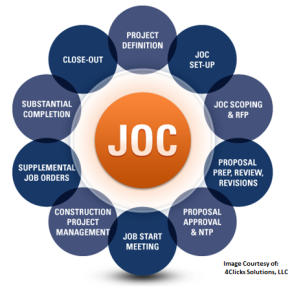Author: David Carrithers
With state and local governments facing severe revenue shortfalls, all publicly-funded organizations, facilities and infrastructures have new demands put on them to find ways to get more done with less—less internal resources and less money. As a result, more facilities and government agencies are turning to job order contracting (JOC) to support their construction, renovation and repair efforts. Here are five ways a successful JOC program saves money:
1. Budget control. JOC uses pre-established unit prices, found in a unit price book. When seeking a contractor for repair, renovation and minor construction projects, the owner cites a unit price book in its request for proposal (RFP) while putting the JOC program together. The contractor offers a price coefficient for the work and materials, establishing its competitiveness up front—without knowing quantities, schedules or timing. Once the JOC program is in place the individual project/ task orders are managed through a defined process. The owner accepts the project proposal, which includes a detailed project scope document and detailed line item estimate, every project’s price is fixed once the proposal is accepted, so there are no budget surprises.
2. More funds applied to construction work instead of administration of RFPs. Without JOC, the owner must procure each project individually in the traditional design-bid-build procurement method. This adds costs—those of design, advertising, reviewing, potential re-bidding based on response, awarding and administering separate RFPs / solicitations for every project— for what are often smaller, repetitive construction projects. JOC allows the owner to shift its attention from procurement processing to the reduction of its backlog. All the dollars saved on procurement can be saved or go toward construction efforts.
3. Eliminated contractor driven change orders and legal claims. Individual projects under JOC receive upfront definition through detailed scope documents prepared by the contactor to match the owner’s objectives, budget and timeline. The precision put into preparation of the scope documents, detailed line item estimates and the project proposal eliminates change orders and claims.
4. Owner and contractor goals are aligned. Seeking to receive additional job orders and remain an extension of the owner’s team, only earning the right for future opportunities to serve the client through performance the contractor naturally focuses on providing the owner with only its very best solutions, including creativity in cost effective ideas.
5. Support of local small and minority businesses. More building funds stay close to home, because the professional JOC contractor retained under a JOC program manages the construction work by using small and minority local subcontractors who typically are most cost effective and operate locally – hiring local people and using local resources.



